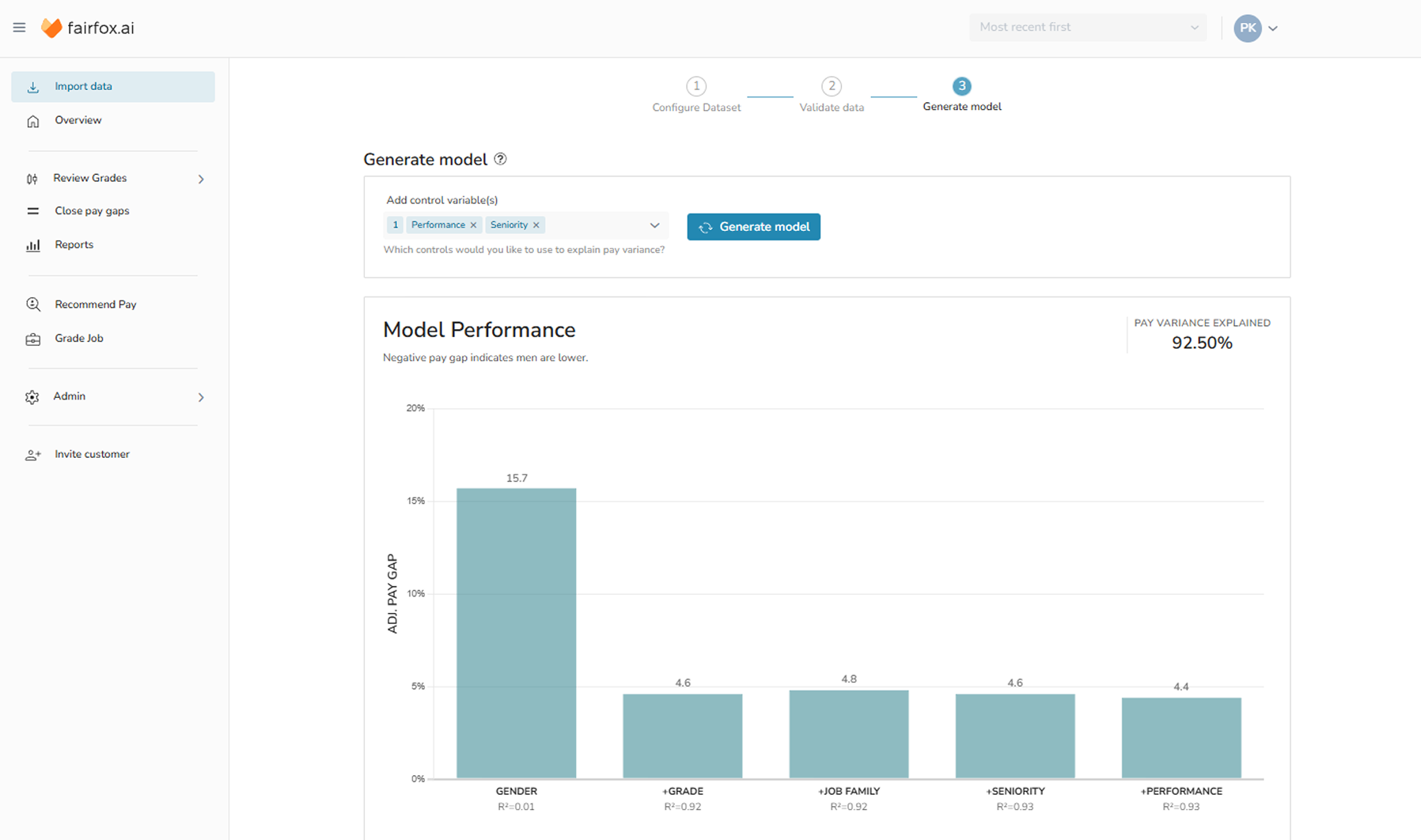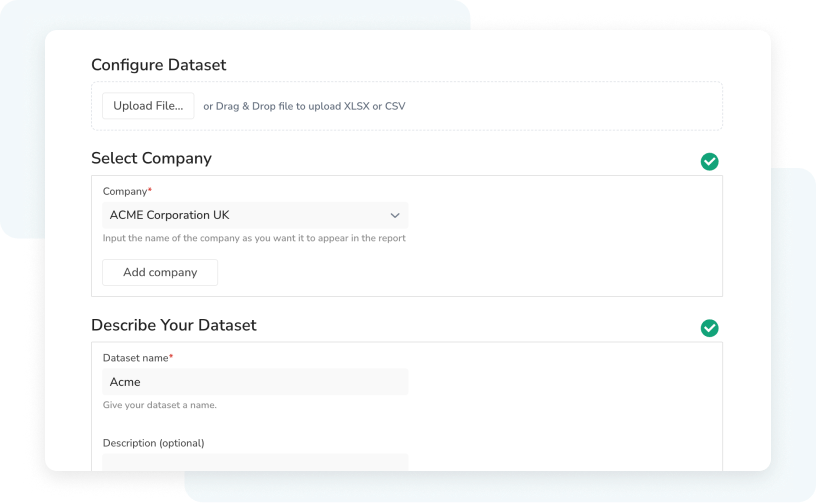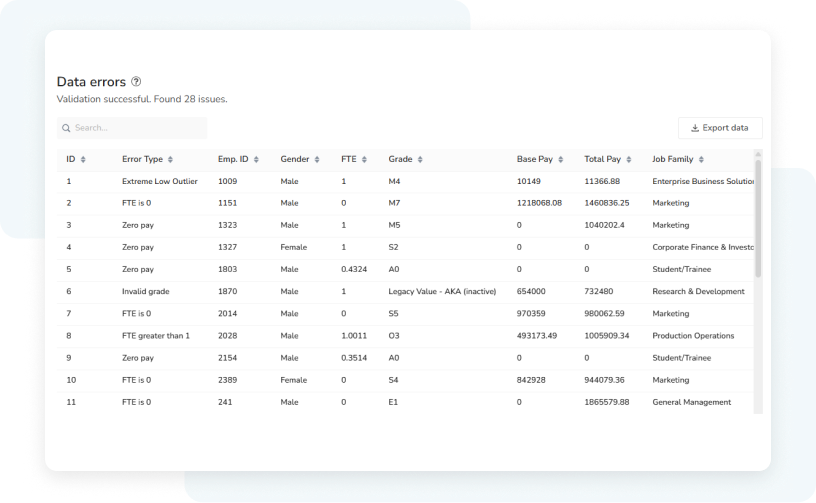Measure Pay Gaps
Calculate the optimal pay adjustments to close pay gaps to target

Import, validate, and transform your data in minutes. Build pay models based on what actually drives pay in your organization with gold-standard statistics.
Get started in minutes
Data import takes minutes: export from your HRIS, complete our template, and upload. Fairfox guides you through mapping and validation, catching errors before analysis. The platform automatically normalizes pay for part-time vs. full-time employees, ensuring apples-to-apples comparisons.
Track real progress by uploading multiple datasets and measuring the actual impact of your pay equity initiatives.

Automatic data validation
Fairfox automatically screens for inconsistencies that could skew your pay equity analysis. Our data upload process includes a comprehensive validation step that checks for missing values, salary outliers, duplicate records, and other common data issues that may distort your results.
Each error is clearly coded and categorized, allowing you to easily identify and prioritize the issues in your data. Errors are summarized in an easy-to-understand report for quick corrections in your source system, exportable as XLSX for sharing with your data team. This ensures your pay gap analysis is built on clean, reliable data that produces accurate and defensible results.

Customizable pay model
Customize your analysis to reflect how pay actually works in your organization. Choose the factors that drive compensation decisions - experience, education, performance, location - rather than relying on generic models that may not fit your company's reality.
Fairfox uses nested log-linear regression modeling, creating separate statistical models for each grade group with adequate sample size (100+ employees). This approach captures how pay factors impact different levels differently, delivering more accurate gap measurements than single, organization-wide models.
Additional Resources
Calculate fair pay
Calculate equitable pay ranges for promotions and new hires
Validate pay grades
Identify and correct outliers with our AI powered grade review tool.
Close Pay Gaps
Close pay gaps with confidence using our recommendations engine.
Frequently Asked Questions
How much data do I need to get started
You'll need at least 100 employees to get meaningful results, which is also the cutpoint for the directive. With smaller teams, the statistical analysis just isn't reliable enough - there aren't enough data points to spot real patterns versus random noise. Think of it like trying to understand your company's average salary from just 10 people - the numbers can swing wildly based on who you include.
Most companies see much clearer insights once they hit 200+ employees, since there are more people across different roles and departments to compare. But 100 is the sweet spot where the analysis starts being genuinely useful for compliance and decision-making.
What if our data is messy or incomplete?
Don't worry - messy data is the norm, not the exception! We see everything from missing job titles to inconsistent salary records to employees listed in the wrong departments. It's actually pretty rare when a company's data is perfectly clean from the start.
Fairfox automatically flags the most common data issues during upload - things like missing values, salary outliers, or inconsistent job codes. We'll show you exactly what needs fixing and give you a clear report to share with your data team. Most companies can clean up the critical issues in a day or two.
The key is having enough core information - employee ID, salary, job title, and basic demographics. Even if some fields are incomplete, we can usually work with what you have and help you prioritize which gaps matter most for accurate analysis.
How do you ensure our data stays secure during analysis?
We take data security seriously - your pay information is some of the most sensitive data your company has. Fairfox is ISO 27001 certified and fully GDPR compliant, with all data hosted on secure European servers so it never leaves the region.
Your data is encrypted both in transit and at rest, and we use role-based access controls so only authorized team members can see what they need to see. We also maintain complete audit trails of who accessed what data and when, which helps with both internal governance and compliance reporting.
Plus, since we don't integrate directly with your systems, you have full control over what data gets uploaded and can remove it anytime. Many of our clients appreciate having that extra layer of control, especially when dealing with executive compensation data.
Can we keep data in our own environment?
Yes, absolutely! We understand that some companies need to keep their pay data within their own infrastructure for security or compliance reasons. With our enterprise license, Fairfox can be deployed directly in your own environment - whether that's your private cloud, on-premises servers, or your preferred hosting setup.
This gives you complete control over where your data lives while still getting all the benefits of our AI-powered analytics and expert guidance. You get the same platform features and support, just hosted exactly where you need it to be.
The enterprise deployment is perfect for larger organizations with strict data governance requirements or companies in highly regulated industries who need that extra peace of mind about data location and control.
Do I need to know statistics to use the system?
Honestly, it's a huge difference. Most companies tell us manual pay equity analysis takes 4-8 weeks of full-time work - and that's if you have someone who knows what they're doing. You're looking at weeks of data cleaning, building statistical models in Excel or R, running calculations, and trying to figure out which pay gaps are actually problematic versus just noise.
With Fairfox, that same analysis happens in hours, not weeks. Our AI automatically detects patterns and flags real issues while our predictive analytics tell you exactly how much each adjustment should be. Upload your data and get clear results showing not just where your pay gaps are, but the optimal way to fix them.
Here's the thing - even if you could do the analysis manually, you'd probably make expensive mistakes. Most people go with gut instinct on pay adjustments, which can cost way more than needed or create new inequities. Our optimization algorithms calculate the most cost-effective and fair solution, so you're not overpaying or accidentally making things worse.
Plus, our experts guide you through what the AI found and why the recommendations make sense, so you're confident in your decisions.


